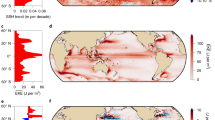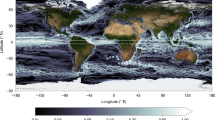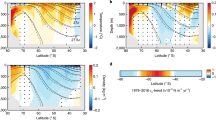Abstract
The Southern Ocean plays a pivotal role in the global ocean circulation and climate1,2,3. There, the deep water masses of the world ocean upwell to the surface and subsequently sink to intermediate and abyssal depths, forming two overturning cells that exchange substantial quantities of heat and carbon with the atmosphere4,5. The sensitivity of the upper cell to climatic changes in forcing is relatively well established6. However, little is known about how the lower cell responds, and in particular whether small-scale mixing in the abyssal Southern Ocean, an important controlling process of the lower cell7,8, is influenced by atmospheric forcing. Here, we present observational evidence that relates changes in abyssal mixing to oceanic eddy variability on timescales of months to decades. Observational estimates of mixing rates, obtained along a repeat hydrographic transect across Drake Passage, are shown to be dependent on local oceanic eddy energy, derived from moored current meter and altimetric measurements. As the intensity of the regional eddy field is regulated by the Southern Hemisphere westerly winds9,10, our findings suggest that Southern Ocean abyssal mixing and overturning are sensitive to climatic perturbations in wind forcing.
This is a preview of subscription content, access via your institution
Access options
Subscribe to this journal
Receive 12 print issues and online access
$259.00 per year
only $21.58 per issue
Buy this article
- Purchase on Springer Link
- Instant access to full article PDF
Prices may be subject to local taxes which are calculated during checkout




Similar content being viewed by others
References
Toggweiler, J. R. & Russell, J. Ocean circulation in a warming climate. Nature 451, 286–288 (2008).
Skinner, L. C., Fallon, S., Waelbroeck, C., Michel, E. & Barker, S. Ventilation of the deep Southern Ocean and deglacial CO2 rise. Science 328, 1147–1151 (2010).
Rintoul, S. & Naveira Garabato, A. C. Ocean circulation and Climate: A 21st Century Perspective. International GeophysicsCh. 18, 471–491 (Academic, 2013).
Lumpkin, R. & Speer, K. Global ocean meridional overturning. J. Phys. Oceanogr. 37, 2550–2562 (2007).
Lauderdale, J. M., Naveira Garabato, A. C., Oliver, K. I. C., Follows, M. J. & Williams, R. G. Wind-driven changes in Southern Ocean residual circulation, ocean carbon reservoirs and atmospheric CO2 . Clim. Dyn. 41, 2145–2164 (2013).
Marshall, J. & Speer, K. Closure of the meridional overturning circulation through Southern Ocean upwelling. Nature Geosci. 5, 171–180 (2012).
Ito, M. & Marshall, J. Control of lower-limb overturning circulation in the Southern Ocean by diapycnal mixing and mesoscale eddy transfer. J. Phys. Oceanogr. 38, 2832–2845 (2008).
Nikurashin, M. & Vallis, R. A theory of deep stratification and overturning circulation in the ocean. J. Phys. Oceanogr. 41, 485–502 (2011).
Meredith, M. P. & Hogg, A. M. Circumpolar response of Southern Ocean eddy activity to a change in the Southern Annular Mode. Geophys. Res. Lett. 33, L16608 (2006).
Morrow, R., Ward, M. L., Hogg, A. M. & Pasquet, S. Eddy response to Southern Ocean climate modes. J. Geophys. Res. 115, C10030 (2010).
Sloyan, B. & Rintoul, S. R. The Southern Ocean limb of the global deep overturning circulation. J. Phys. Oceanogr. 31, 143–173 (2001).
Nikurashin, M., Vallis, R. & Adcroft, A. Routes to energy dissipation for geostrophic flows in the Southern Ocean. Nature Geosci. 6, 48–51 (2013).
St. Laurent, L. et al. Turbulence and diapycnal mixing in Drake Passage. J. Phys. Oceanogr. 42, 2143–2152 (2012).
Waterman, S., Naveira Garabato, A. C. & Polzin, K. L. Internal waves and turbulence in the Antarctic Circumpolar Current. J. Phys. Oceanogr. 43, 259–282 (2013).
Sheen, K. L. et al. Rates and mechanisms of turbulent dissipation and mixing in the Southern Ocean: Results from the Diapycnal and Isopycnal Mixing Experiment in the Southern Ocean (DIMES). J. Geophys. Res. 118, 1–19 (2013).
Nikurashin, M. & Ferrari, R. Radiation and dissipation of internal waves generated by geostrophic motions impinging on small-scale topography: Theory. J. Phys. Oceanogr. 40, 1055–1074 (2010).
Scott, R. B., Goff, J. A., Naveira Garabato, A. C. & Nurser, A. J. G. Global rate and spectral characteristics of internal gravity wave generation by geostrophic flow over topography. J. Geophys. Res. 116, C09029 (2011).
Nikurashin, M. & Ferrari, R. Overturning circulation driven by breaking internal waves in the deep ocean. Geophys. Res. Lett. 40, 3133–3137 (2013).
Ferrari, R. & Wunsch, C. Ocean circulation kinetic energy: Reservoirs, sources, and sinks. Annu. Rev. Fluid Mech. 41, 253–282 (2009).
Gregg, M. C., Sanford, T. B. & Winkel, D. P. Reduced mixing from the breaking of internal waves in equatorial waters. Nature 422, 513–515 (2003).
Brearley, J. A., Sheen, K. L., Naveira Garabato, A. C., Smeed, D. A. & Waterman, S. Eddy-induced modulation of turbulent dissipation over rough topography in the Southern Ocean. J. Phys. Oceanogr. 43, 2288–2308 (2013).
Venaille, A. M., Vallis, G. K. & Smith, K. S. Baroclinic turbulence in the ocean: Analysis with primitive equation and quasigeostrophic simulations. J. Phys. Oceanogr. 41, 1605–1606 (2011).
Yin, J. A consistent poleward shift of the storm tracks in simulations of 21st century climate. Geophys. Res. Lett. 32, L18701 (2005).
Thompson, W. J. & Solomon, S. Interpretation of recent Southern Hemisphere climate change. Science 296, 895–899 (2002).
Hallberg, R. & Gnanadesikan, A. The role of eddies in determining the structure and response of the wind-driven Southern Hemisphere overturning: Results from the modeling eddies in the Southern Ocean (MESO) project. J. Phys. Oceanogr. 36, 2232–2252 (2006).
Abernathey, R., Marshall, J. & Ferreira, D. Dependence of Southern Ocean overturning on wind stress. J. Phys. Oceanogr. 41, 2261–2278 (2011).
Stanley, G. J. & Saenko, O. A. Bottom-enhanced diapycnal mixing driven by mesoscale eddies: Sensitivity to wind energy supply. J. Phys. Oceanogr. 44, 68–85 (2014).
Oakey, N. S. Determination of the rate of dissipation of turbulent energy from simultaneous temperature and velocity shear microstructure measurements. J. Phys. Oceanogr. 12, 256–271 (1982).
Orsi, A. H., Whitworth, T. III, Worth, D. & Nowlin, W. D. Jr On the meridional extent and fronts of the Antarctic Circumpolar Current. Deep-Sea Res. I 42, 641–673 (1995).
Acknowledgements
The DIMES experiment is supported by the Natural Environment Research Council (NERC) of the UK and the US National Science Foundation. K.L.S. is supported by NERC. We are grateful to J. Ledwell, A. Bogdanoff, P. Courtois, K. Decoteau, D. Evans and X. Liang for their help in data collection and acknowledge the valuable assistance and hard work of the crew and technicians on the RRS James Cook, the RRS James Clark Ross and the RV Thomas G. Thompson. We also thank A. Thompson who provided many helpful comments, and E. Murowinski, R. Lueck and F. Wolk from Rockland Scientific for their support in microstructure data analysis.
Author information
Authors and Affiliations
Contributions
K.L.S. conducted most of the data analysis. A.C.N.G. and K.L.S. conceived the idea for the work and wrote the manuscript. J.A.B. processed the mooring current velocity data and computed the mooring turbulent dissipation time series. K.L.S., J.A.B., A.C.N.G., A.F. and L.S.L. collected and processed microstructure data. B.A.K. was instrumental in collecting hydrographic data along the repeat SR1b section. A.M.T. collected and processed lowered-ADCP data for the three DIMES SR1b sections. A.C.N.G., J.M.T., D.A.S. and A.J.W. conceived and directed the DIMES project and along with J-B.S. planned research cruises. M.P.M., K.L.P., D.A.S., J-B.S. and S.N.W. gave analytical and conceptual advice throughout the project.
Corresponding author
Ethics declarations
Competing interests
The authors declare no competing financial interests.
Supplementary information
Supplementary Information
Supplementary Information (PDF 18849 kb)
Rights and permissions
About this article
Cite this article
Sheen, K., Naveira Garabato, A., Brearley, J. et al. Eddy-induced variability in Southern Ocean abyssal mixing on climatic timescales. Nature Geosci 7, 577–582 (2014). https://doi.org/10.1038/ngeo2200
Received:
Accepted:
Published:
Issue Date:
DOI: https://doi.org/10.1038/ngeo2200
This article is cited by
-
Distinct iron cycling in a Southern Ocean eddy
Nature Communications (2020)
-
Internal wave-driven mixing: governing processes and consequences for climate
Nature Reviews Earth & Environment (2020)
-
Intraseasonal oscillation of deep currents influenced by mesoscale eddies in the Kuroshio Extension Region
Scientific Reports (2019)
-
Stabilization of dense Antarctic water supply to the Atlantic Ocean overturning circulation
Nature Climate Change (2019)
-
Spiraling pathways of global deep waters to the surface of the Southern Ocean
Nature Communications (2017)



